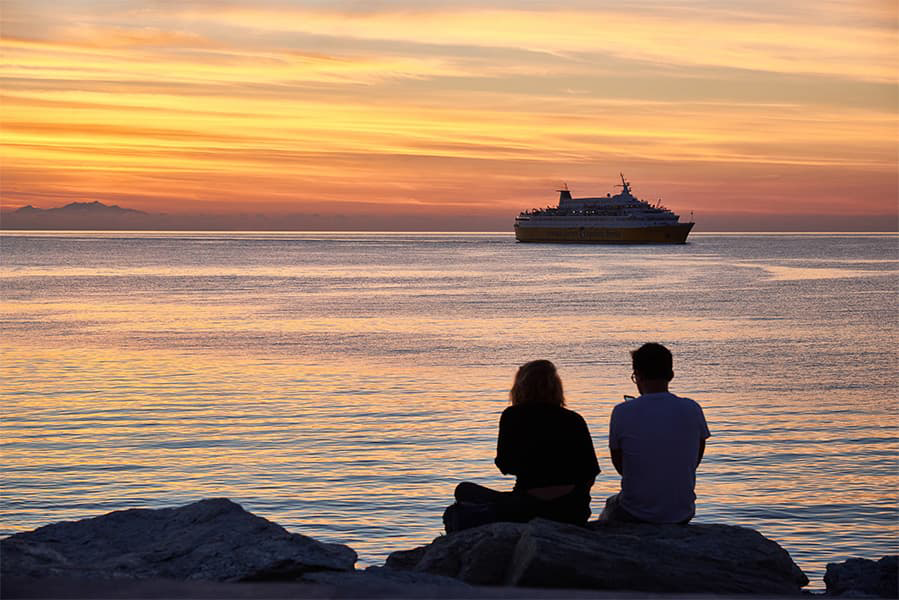Macau (Outer Harbour) - Hong Kong Airport (Skypier)
Ferries to Hong Kong
Macau (Outer Harbour) - Hong Kong Airport (Skypier)
Ferries to Hong Kong

The Macau to Hong Kong ferry route is provided by 1 operator and is available for booking during the high season. The ferry crossing from Macau to Hong Kong takes approximately 1 hour on ferries servicing this route. Macau to Hong Kong ferry duration can range between 1 hour and 1 hour 10 minutes depending on the operator that you decide to travel with and weather conditions.
There are around 21 ferry weekly sailings from Macau to Hong Kong Airport. TurboJet provide up to 3 sailings per day. Ferry timetables often increase during the high season.
The fastest ferry from Macau to Hong Kong Airport is with TurboJet.
There are no cabins on ferries from Macau to Hong Kong.
Prices subject to change, pricing representative of searches over last 30 days.
Find cheap ferry tickets using our deal finder. It is highly recommended that you book in advance to ensure yourself the best possible prices and availability on this service.
With up to 3 sailings per day, you are bound to find a suitable ferry crossing to suit your needs. However, there are alternative routes to explore if you require additional flexibility including the Macau to Hong Kong (Sheung Wan) ferry route.
More routes than anyone else.

Compare fares, times & routes in one place.
Change plans easily with flexi tickets.

Book e-tickets & manage trips in-app.
Live ship tracking & real-time updates.

Top-rated customer support when you need it.
| Macau (Outer Harbour) - Hong Kong Airport (Skypier) Route summary | ||
|---|---|---|
| Departure Country | Macau | |
| Destination Country | Hong Kong | |
| No. of Operators | 1 | |
| Operators | TurboJet | |
| Average Price | $77* | |
| Average Weekly Sailings | 1 | |
| Average Sailing Duration | 1h 0m | |
| First Ferry | 10:45 | |
| Distance | 23 nautical miles | |
* Prices subject to change, pricing is taken from last 30 days, last updated 2024-11-05.
Macau borders the city of Zhuhai on the south east coast of China. The port serves passengers with ferry routes to other areas of China, though predominantly it is used to transport passengers to Hong Kong. There are around 77 crossings per day to Hong Kong, typically lasting just under an hour. With a population of just over 650,000 living in an area of 30.5 km2, Macau lies in the most densely populated region in the world. Macau has recently been dubbed as the ‘Las Vegas of China’ due to the abundance of extravagant casinos making it a haven of gambling and glamour. It differs, however, from Las Vegas in its class and diversity; being a Portuguese colony for several hundred years, there is a mix of Asian and Western European culture that is unique to the city. Away from the casinos and restaurants, plenty of history can be enjoyed around the city. St Paul’s ruins are a must-see whilst in the area, especially for a change of scenery from the tall buildings and buzzing streets. For an even greater change in landscape, head to Old Taipa Village for a chance to spend time with the local people and learn about their traditional faith and values. Macau is dense enough that the majority of the major attractions are found in the city centre, therefore are generally within walking distance of each other. For transport to the ferry terminal, there is a bus service that stops directly outside the port, though the lack of English spoken can make it hard for visitors to negotiate with the driver. It may be best advised for tourists to get a taxi on their first visit.
The soaring skyscrapers among the hectic street markets is part of the reason Hong Kong Port is widely regarded as the symbol of East meeting West. The region is incredibly easy to navigate through due to the sheer number of tourists; signs are written in both English and Mandarin and if that isn’t enough the locals are more than happy to help any lost tourists. Many skyscrapers consist of restaurants, bars and even hotels, sometimes on the same floor; visitors could never complain of a lack of things to do. Hong Kong Port is located just outside of the airport, making it an ideal spot for visitors flying into Hong Kong. As a coastal city, Hong Kong relies on the fluidity, flexibility and frequency of its water transportation system; to accommodate the increasing number of visitors, a new cruise terminal was introduced in 2013. The cruise terminal was brought in with the intention to occupy two mega cruise ships, hosting luxurious experiences for those wishing to use the service. The vast majority of ferry routes from the port are heading to regions of China, with two types of ferries in operation; the standard ferries or the slightly more expensive fast ferries. A domestic crossing is available - Star Ferry carries passengers across the Victoria Harbour between Hong Kong Island and Kowloon.